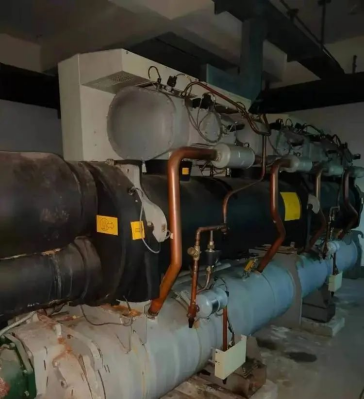Refrigeration system, cooling water system, refrigerant water system and water defrosting system pipes, flanges, valves, liquid pumps and containers, etc., in the ever-changing pressure and temperature for a long time, by the refrigerant, refrigerant, water, air and other corrosive, its structure and materials will occur to varying degrees of thinning or deformation, to the extent that the limit of the extent of the accident may occur.
1.Repair of local deformation of pipeline
To eliminate local deformation phenomenon, it is necessary to find out the reason from the structure and operation. Such as cold storage wall exhaust pipe by the accumulation of frost load caused by too much deformation, should strengthen the defrosting work. If the pipeline is too long, the deformation caused by the spacing of the bracket or hanger, the bracket or hanger should be increased. If the deformation is not large, does not affect the continued use, can wait for the overhaul and then repair, but should strengthen the inspection and maintenance work. If the tube is bent seriously, the bent part of the tube can be cut after the refrigerant in the tube is emptied and put on the corrector to straighten it. Pressurisation is required to be even and slow, do not hit with a sledgehammer, and the straightened pipe is then connected to the exhaust pipe.
2. Repair of pipe cracks and pinholes
For cracks and pinholes in the equipment is not big, generally use the welding method of repair. If the gas welding leakage, welding leaks should not be more than 2 times, or should be replaced to deal with the pipe. When welding the leakage point, it is forbidden to work in the environment with thick refrigerant.

3. Flange overhaul
1) Check the preload of the bolts at the connection of the flange, if they are loose, tighten the nuts symmetrically with a spanner to make the force uniform, but should not be too tight. If the bolts are deformed or corroded seriously, new bolts should be replaced.
2) The asbestos gasket at the flange connection is corroded or burnt out, resulting in the loss of sealing ability, and should be replaced with a new gasket. Before replacing the new gasket, the original gasket should be scraped off and cleaned with paraffin to check whether the flange sealing line is corroded or damaged. If there is no problem can be replaced with a new gasket, diagonal uniform tightening of the flange bolts can be. If the sealing surface of the flange is subject to serious corrosion or sealing line damage, you can replace the new flange or repair qualified and then installed on the new gasket to prevent the use of leakage.
3)The welding seam is not tight, should be welded repair.
4)If the welding causes the flange to warp and does not meet the assembly requirements, it should be turned and processed or replaced.
5)In the process of installation, if the two flanges centre line is not the same, its contact surface draft is not uniform, the pipe should be cut off and re-welded.
4. Valve repair
1) Replacement of packing. The main role of the packing is to prevent the work material along the valve stem axial leakage and set up. In case of minor leakage, can tighten the packing gland, such as leakage can not be excluded, should replace the packing. Replacement of the valve stem must be screwed out to the end, with the packing pin to the old packing out, and then ready to screw the new packing in order, and then tighten the gland.
2) Repair the spool. In air-conditioning and refrigeration projects, where the large diameter of the valve, the spool is dependent on a layer of pasteurised alloy or fluorine plastic seal. The back of the spool also has a layer of pasteurised alloy, so that when the valve stem is screwed out to the bottom position, it can seal the material without leaking outwards along the valve stem.
When the valve is disassembled, first straighten the valve stem to deburr, and then replace the spool of the pasteurised alloy, and at the same time, the valve seat should also be ground, so that the spool and the seat of the valve with each other tight.
For small cast steel or brass valve spool, the seal of this valve all rely on a line of metal contact to obtain, so called line seal. Because it is a line seal, and thus the valve seat and spool should be carefully ground in order to obtain a more satisfactory sealing effect.
Valve repair is completed, should be in accordance with the relevant requirements of the airtightness test.
Refrigeration system in the repair of the safety valve is also roughly the same as the above, but because of the softer pasteurised alloy, often due to overpressure and the action of the safety valve after a time, it is difficult to return to the original position, so when the pressure drops to the closing pressure, still shut off is not tight. In order to overcome this defect, some products have been replaced with nickel-chromium-titanium alloy (hard) alloy, or with polytetrafluoroethylene instead.
Post time: Oct-11-2023







